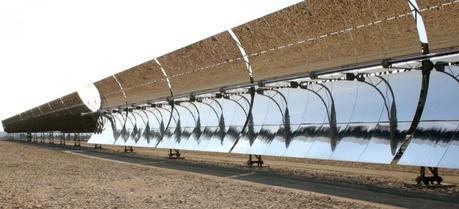 The Kuraymat Integrated Solar Combined Cycle (ISCC) project site is situated nearly 55 miles south of Cairo, Egypt. (Credit: Flickr @ Green Prophet http://www.flickr.com/photos/69471202@N07/)
The Kuraymat Integrated Solar Combined Cycle (ISCC) project site is situated nearly 55 miles south of Cairo, Egypt. (Credit: Flickr @ Green Prophet http://www.flickr.com/photos/69471202@N07/)
According to a new report by the Middle East Solar Industry Association, the Middle East and North Africa (Mena) region could see more than $50 billion worth of investment in its solar power sector by 2020 as regional governments push for the adoption of clean energy and take advantage of the region’s high solar irradiation levels.
According to the Mena Solar Energy Report 2014, published by MEED Insight in association with the Middle East Solar Industry Association (MESIA), up to 37,000 MW of new solar, wind and hydroelectric projects are planned to be commissioned by the end of the decade, of which between 12,000 MW and 15,000 MW will be sourced from solar energy projects specifically.
“Of the 14 countries covered in-depth by this report, installed electricity generating capacity totals almost 260,000 MW,” says Ed James, Head of MEED Insight and report author. “Of this, installed solar capacity, excluding the thermal elements on integrated solar combined-cycle schemes (ISCCs), stood at just 271 MW as of January 2014. Renewable energy as a whole including hydropower and wind power comprises over 16,600 MW, representing over 6 per cent of the total, came from renewable energy sources. The majority was in the form of hydroelectric power plants with a capacity of 15,205 MW, while wind energy contributed 1,129 MW.”
The contribution of solar power to the energy mix will change radically over the next seven years as governments embrace renewable energy in the wake of rapidly growing power demand and the increasing strain on existing fossil fuel resources. A MEED Insight survey concludes that the MENA solar energy capacity could grow to 15,000 MW by the end of 2020, split equally between photovoltaic (PV) and concentrating solar power (CSP) technologies. If current plans materialise, the estimated direct investment in solar energy projects, excluding transmission and distribution investments, will amount to approximately $50bn at 2013 prices.
“By far the largest potential solar power market in the region is Saudi Arabia. In its recently published White Paper, the King Abdullah City for Atomic & Renewable Energy (KA-Care)—the body responsible for overseeing the kingdom’s renewable and alternative energy programs—said it envisaged installing 23,900 MW of renewable energy by 2020,” says James. “The majority of that total would be split between CSP and solar photovoltaic PV projects. If realized, the program would be one of the largest single solar power initiatives not just in the region but in the world.”
While Saudi Arabia is set to become the undoubted leader in solar power in the region, a number of other countries have set themselves ambitious targets. Morocco Egypt and Algeria plan to have at least 1,500 MW, 1,800 MW and 3,000 MW of solar power in place respectively, most of which will be solar based.
However, to achieve their ambitious objectives each country will have to work hard to ensure the right regulatory frameworks and conditions exist in order to attract the necessary investment. “Currently, there lacks a cohesive approach to developing a renewable energy industry,” says James. “Governments need to provide the necessary financial and regulatory incentives such as feed-in tariff, net metering and tax breaks if investment is to be attracted and to grow. While there is evidence that this is happening, it needs to accelerate if the ambitious 2020 targets are to be achieved.”
“Prior work by MESIA has shown that solar power has become commercially viable in the Mena region due to dramatic reductions in solar equipment costs, a good fit of solar resources with regional power demand patterns, and increasingly limited access to cheap hydrocarbons for power generation,” says Dr Steve Griffiths, Research Director at MESIA. “Nonetheless, regional challenges exist for achieving widespread deployment of solar power, including lack of supportive policy frameworks, subsidies for fossil-based power generation, and access to financing.

